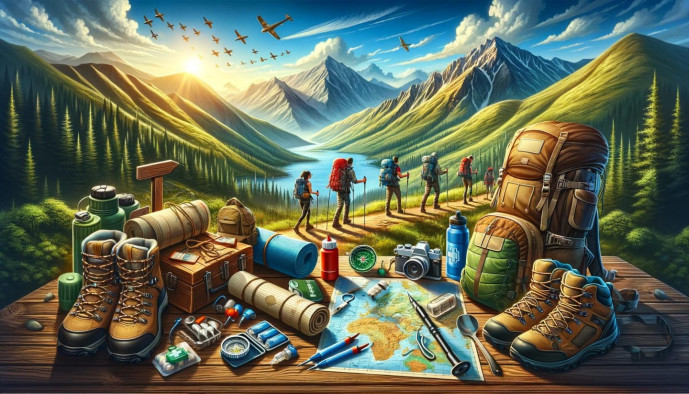Trekking Gear Checklist
Your comprehensive checklist for a successful and safe trekking trip

Venturing into high mountain terrains is a thrilling adventure that requires more than just enthusiasm and physical strength. It requires preparation. One of the most crucial parts of this preparation is having the right gear. But why exactly does gear matter so much?
Why Good Gear Matters
High-quality gear can significantly enhance your trekking experience. It provides you with the protection and comfort you need to tackle the challenging terrains and weather conditions common in high mountain environments. Moreover, it can make the difference between a pleasant and memorable trek and one that you’d rather forget. Have you ever tried trekking with subpar gear? If so, you know what we’re talking about!
The Consequences of Neglecting Proper Gear
On the flip side, neglecting proper gear can lead to unpleasant situations or, worse, serious risks. Poorly insulated clothing might leave you vulnerable to hypothermia, while inadequate camping gear could expose you to the harsh elements. A poor gear choice could potentially put your life in danger, so it’s best to take this aspect seriously.
Understanding the High Mountain Environment
Before diving into the gear checklist, let’s take a moment to understand the environment you’ll be facing.
Weather Conditions in High Mountains
High mountains are known for their unpredictable weather. Within the span of a day, you could experience bright sunshine, chilling winds, and sudden snowfall. Being prepared for these varying conditions is key to a successful trek.
The Terrain: What to Expect
High mountain terrain can be challenging. Expect steep inclines, loose gravel, rocky surfaces, and perhaps even snow or ice. Your gear should be able to withstand these challenges and help you navigate the terrain safely and comfortably.
Gear Checklist: Breaking Down What You Need
Now let’s break down the gear you’ll need for your high mountain trek.
Essential Trekking Equipment
The right trekking equipment can make your journey smoother and safer.
Trekking Poles: Why You Need Them
Trekking poles are more than just a support; they help maintain balance, reduce stress on your joints, and even aid in setting up your tent. Choose poles that are lightweight yet sturdy, and adjustable to your height.
Maps and Compasses: Navigating the Wilderness
Even in the age of GPS, a physical map and compass can be your best friends when trekking in remote high mountain regions. They don’t rely on battery power and can provide a reliable way to navigate the trails and keep track of your location.
Essential Clothing Items
The right clothing can protect you from the elements and keep you comfortable throughout the trek.
Base Layers: The First Line of Defense
Your base layers keep you dry by wicking away sweat from your body. Opt for materials like merino wool or synthetic fabrics that dry quickly and manage moisture well.
Insulation: Staying Warm in the Cold
Insulating mid-layers are vital for keeping you warm in the freezing mountain temperatures. Think fleece jackets, down vests, or synthetic jackets.
Outer Layers: Protection Against the Elements
Your outer layer, or shell, protects you from wind, rain, and snow. Waterproof, breathable jackets and pants are the best choice for this layer.
Essential Camping Gear
A high mountain trek usually involves camping. Here’s the camping gear you’ll need.
Tents: Your Home in the Mountains
A sturdy, waterproof, and wind-resistant tent is a must. Consider factors like weight, size, and ease of setup when choosing your tent.
Sleeping Bags: Ensuring a Good Night’s Sleep
Select a sleeping bag suitable for the lowest temperature you expect to encounter. Remember, a good night’s sleep can make a world of difference to your trekking experience.
Cooking Gear: Feeding Yourself in the Wild
Portable stoves, fuel, lightweight cookware, and utensils are all part of the essential cooking gear. Don’t forget your water purifier or water purification tablets either.
Essential Safety Items
Safety should always be your top priority when trekking in high mountains.
First Aid Kit: Be Prepared for Emergencies
A first aid kit is an absolute must. It should include bandages, antiseptic wipes, tweezers, medical tape, pain relievers, and any personal medication you might need.
Headlamps/Flashlights: Lighting Your Way
Headlamps or flashlights are essential for navigating in the dark and for any emergencies that might arise. Remember to pack extra batteries too.
Multi-tool: The Handy Helper
A multi-tool can be a lifesaver in the wilderness. Look for one that includes a knife, screwdriver, scissors, can opener, and tweezers.
Selecting Your Gear: What to Consider
When choosing your gear, consider these factors to ensure you make the best choice.
Weight: Lighter is Better
The weight of your gear can significantly affect your trekking experience. After all, you’ll be carrying it all on your back. Opt for lighter gear whenever possible, but don’t compromise on quality and functionality.
Durability: Gear that Stands the Test of Time
Your gear should be able to withstand the harsh conditions of high mountain treks. Prioritize durable, high-quality gear that won’t fail you when you need it the most.
Comfort: Ensuring a Pleasant Experience
From your clothing to your backpack, all your gear should be comfortable. Remember, discomfort can be a real dampener on your trekking experience.
Caring for Your Gear: Maintenance Tips
Proper care can extend the life of your gear and ensure it performs well.
Cleaning Your Gear: Do’s and Don’ts
Cleaning your gear appropriately after each trek is important. However, avoid harsh detergents or machine washing if it’s not recommended by the manufacturer.
Storing Your Gear: Preserving its Life
Store your gear in a dry, cool place away from direct sunlight. Make sure all gear is completely dry before storing to prevent mildew.
Conclusion: Being Prepared is Half the Victory
The right gear is a key aspect of a successful high mountain trek. By ensuring you have all the essentials and knowing how to choose and care for them, you’re already halfway to a successful adventure. So, are you ready for your high mountain trek?